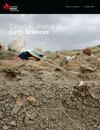Magnetotelluric imaging of the magmatic and geothermal systems beneath Mount Meager, southwestern Canada
IF 1.6
4区 地球科学
Q3 GEOSCIENCES, MULTIDISCIPLINARY
引用次数: 0
Abstract
Magnetotelluric data were collected on and around the Mount Meager Volcanic Complex, an active volcanic complex with eruptions ~2,400 and ~24,300 years ago. 3-D inversion was used to create an electrical resistivity model to a depth > 20 km. The model is characterized by high resistivity (> 100 Ωm) in the upper 6-7 km, implying relatively dry, unaltered rock. Within this resistive layer, localized conductors are observed in the upper 2 km beneath Pylon Peak and Fish Creek, corresponding to low-permeability clay-rich layers, acting as caprocks to geothermal fluids below. Beneath the resistive upper crust, there is a large conductor at ~5-15 km below sea level with an average resistivity of ~3 Ωm. Laboratory experiments of melt resistivity and petrological data from erupted volcanic rocks were used to interpret the model. The magma body (deep conductor) is inferred to have a minimum volume of ~2×10^12 m^3 comprising ~18-32% dacitic-to-trachydacitic melt with ~6-8 wt% H2O at a temperature of ~800-900ºC. This is below the melt fraction of an eruptible magma body. Resolution tests suggest it might be regional in extent, not localized beneath Mount Meager. There are fluid pathways from the northern part of the magma body, up toward Mount Meager and nearby fumaroles. This model is a significant advancement from its predecessors, created 20-40 years ago, providing the first deep 3-D image of this volcanic system. Along with other geophysical and geological models of the Garibaldi Geothermal Energy Project, it will reduce the exploration risk associated with geothermal energy development.加拿大西南部蒂尼山地下岩浆和地热系统的大地电磁成像
大地电磁资料是在蒂尼火山复合体上及其周围收集的,蒂尼火山复合体是一个活火山复合体,大约在2400年至24300年前喷发。利用三维反演技术建立了深度> 20 km的电阻率模型。模型上部6 ~ 7 km具有高电阻率特征(> 100 Ωm),表明岩石相对干燥,未蚀变。在这个电阻层中,在Pylon Peak和Fish Creek下方2公里处观察到局部导体,对应于低渗透的富粘土层,充当地下地热流体的盖层。在具有电阻性的上地壳之下,在海平面以下~5 ~ 15 km处有一条大导体,平均电阻率为~3 Ωm。利用熔体电阻率实验和火山喷发岩石学资料对模型进行了解释。推断岩浆体(深部导体)的最小体积为~2×10^12 m^3,由~18-32%的英质-粗英质熔体和~6-8 wt%的H2O组成,温度为~800-900℃。这低于可喷发岩浆体的熔融部分。分辨率测试表明,它可能是区域性的,而不是蒂尼山下的局部区域。岩浆体北部有流体通道,流向蒂尼山和附近的喷气孔。这个模型与20-40年前创建的模型相比是一个重大的进步,它提供了这个火山系统的第一个深三维图像。与加里波第地热能项目的其他地球物理和地质模型一起,它将降低与地热能开发相关的勘探风险。
本文章由计算机程序翻译,如有差异,请以英文原文为准。
求助全文
约1分钟内获得全文
求助全文
来源期刊

Canadian Journal of Earth Sciences
地学-地球科学综合
CiteScore
2.80
自引率
7.10%
发文量
66
审稿时长
6-12 weeks
期刊介绍:
The Canadian Journal of Earth Sciences reports current research in climate and environmental geoscience; geoarchaeology and forensic geoscience; geochronology and geochemistry; geophysics; GIS and geomatics; hydrology; mineralogy and petrology; mining and engineering geology; ore deposits and economic geology; paleontology, petroleum geology and basin analysis; physical geography and Quaternary geoscience; planetary geoscience; sedimentology and stratigraphy; soil sciences; and structural geology and tectonics. It also publishes special issues that focus on information and studies about a particular segment of earth sciences.
 求助内容:
求助内容: 应助结果提醒方式:
应助结果提醒方式:


